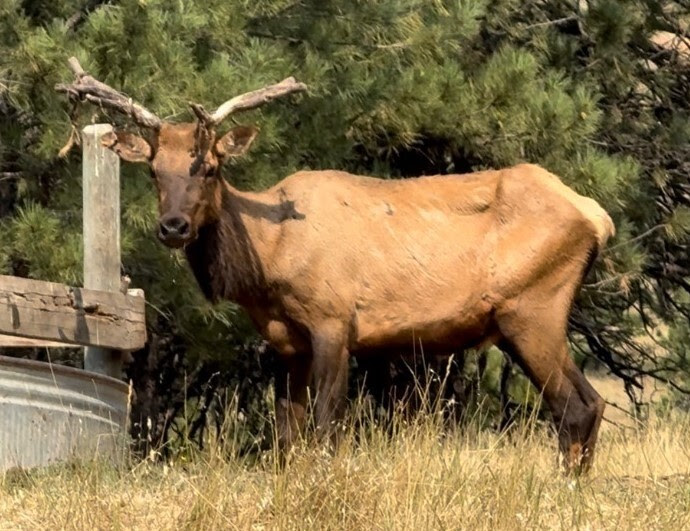
Montana Fish, Wildlife and Parks officials announced on Friday that an elk in southeast Montana tested positive for chronic wasting disease. (Photo by Montana FWP)
Montana Fish, Wildlife and Parks officials announced on Friday that an elk in southeast Montana tested positive for Chronic Wasting Disease. The elk was located on private land in Hunting District 704 north of the Custer National Forest.
This was only the fourth elk across the state to test positive for the always-fatal neurological disease since 2017. However, also in October, a fifth elk tested positive in Hunting District 322 in the Ruby Mountains east of Dillon, a region with the highest concentration of the disease in Montana. This hunter-harvested animal was the first CWD-positive elk in the Ruby Mountains.
According to FWP biologists, the bull elk in southeast Montana was showing symptoms of the disease in mid-October and appeared very thin and lethargic. It was hanging out at a water tank for several days, allowing people to ride horses and drive vehicles close by. When it appeared the elk was showing neurological symptoms and couldn’t pick up its head, FWP officials euthanized it and submitted samples for testing.
Chronic Wasting Disease affects members of the deer family, including elk, moose, mule deer, and white-tailed deer, and is caused by a malformed prion protein. Symptomatic animals can exhibit neurological and behavioral changes and emaciation. The disease always results in death and there is no known cure.
The disease is present in cervid populations in at least 24 states and two Canadian provinces and first appeared in Montana’s wild herds in 2017.
In Montana, the vast majority of cases — 99% — have been detected in white-tailed deer and mule deer, though officials say that could be a matter of sampling.
“My theory on why we’re just now seeing it in elk is simply the smaller number of samples collected from elk,” FWP biologist Emily Mitchell said. “Due to the ease of pulling a whole deer carcass out, it is more likely for folks to get their deer sampled at an FWP sampling station. However, elk are so much bigger that hunters usually only bring the quarters or meat out of the field, and so they don’t get tested. I think we have such a small sample size of elk that it isn’t that it’s new on the landscape, we just hadn’t gotten enough samples to detect it yet.”
Since CWD appeared in the state in 2017, nearly 40,000 deer have been sampled, compared to just 4,800 elk and 268 moose. There have been three positive cases detected in moose since 2017.

CWD-infected animals may not show significant symptoms until the late stages and typically die in 18 to 24 months.
“I would remind people that just because an animal looks healthy, that doesn’t mean it doesn’t have CWD,” Mitchell said. “Since it takes so long for CWD to kill an animal, it can be in early stages of the disease and look just fine.”
So far this year there have been 50 positive CWD cases out of 1,284 samples tested in Montana. Testing is voluntary for hunters everywhere in the state except for the Libby CWD Management Area, where approximately 2,000 white-tail deer tags and 13 mule deer permits in the region are subject to mandatory testing requirements due to the prevalence of CWD there.
With confirmation of CWD in elk is southeast Montana, FWP is encouraging hunters to have both deer and elk tested so it can get a better idea of disease prevalence in both populations to help guide management decisions. In both species, the lymph nodes in the neck area are extracted and submitted to state labs, with results available within about two weeks.
FWP provides assistance with CWD sampling at all regional headquarters during business hours, and at CWD sampling stations located around the state. Hunters can bring animal heads with a portion of the neck attached and FWP will cover the cost of these samples. Hunters also may follow instructions to collect samples themselves and mail them to state labs at their own cost.
FWP now has a policy that any hunter whose animal tests positive for CWD will receive replacement tags as long as they turn over the entire animal including the head.
There is no known transmission of CWD to humans. However, the Centers for Disease Control and Prevention recommends that hunters harvesting a deer, elk, or moose from an area where CWD is known to be present have their animal tested for CWD prior to consuming the meat and not to consume the meat if the animal tests positive.
To learn more, visit Fish, Wildlife and Park’s CWD website.

